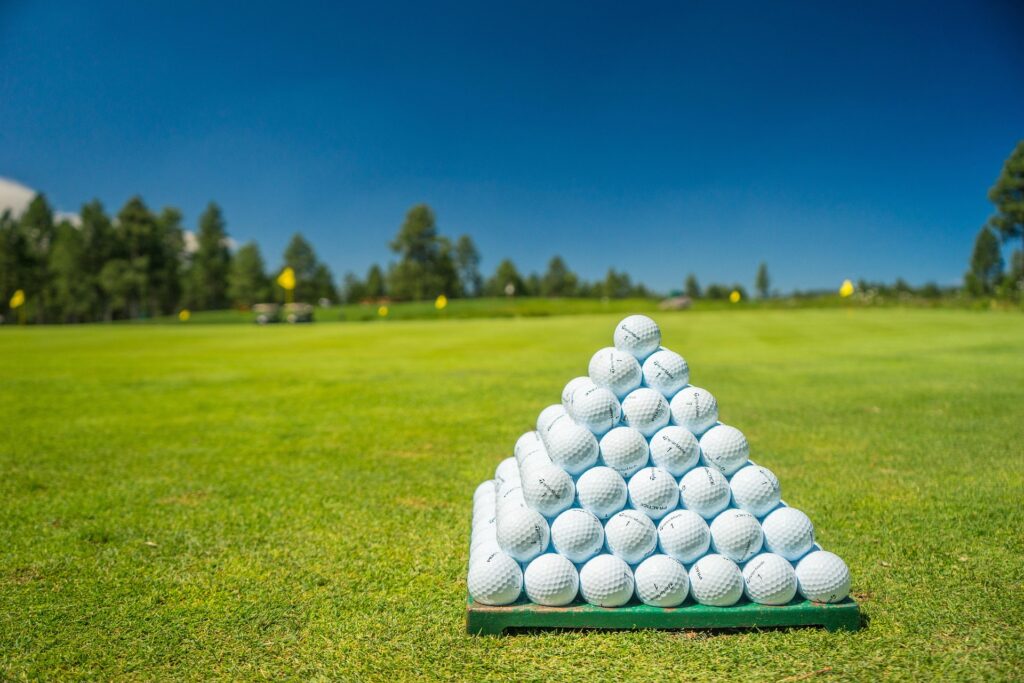
Imagine stepping onto the golf course where everything feels just right. The sun’s warmth is perfectly balanced by a gentle breeze, and that favourite club you’ve grown to trust in your grip. Comfort isn’t just physical—it’s a blend of mental, emotional, and physical ease. The wear of your shoes, the grip of your gloves, or even the soundscape of your favourite golf course touches more than just your sense of touch and hearing.
Now, there’s a strong link between feeling good out there on the green and how confidently you play. Ever noticed how a snug-fitting shirt can make you feel ready to take on the world, or how setting a consistent pre-shot routine can soothe pre-game jitters? That’s comfort fuelling your confidence. Comfort on the course becomes this secret weapon, quietly yet powerfully amplifying our beliefs in our abilities.
The psychological link between comfort and confidence is pretty interesting. When you’re at ease, your mind isn’t distracted by discomfort or stress, allowing you to focus more effectively. This calm focus enhances your ability to trust your instincts and make decisions—decisions that, in the world of golf, can mean the difference between a win and a miss. In this zone, you’re poised to unleash your true potential.
Creating a comfort zone in golf involves more than just physical aspects. Mental comfort, like having strategies to deal with pressure situations, plays a big part too. So, getting familiar with these components brings us one step closer in our golfing journey, understanding the powerful role comfort plays in our level of confidence.
Boosting Confidence through Comfort: Why It Matters
The magic of golf starts when you feel comfortably relaxed, and that sparks confidence like nothing else. Feeling physically comfy, knowing your gear won’t let you down, creates a foundation you can trust. It makes it possible to take every shot believing it’ll land exactly where you picture it.
Routines are game-changers. Getting ready with the same sequence every time, having that tried-and-true morning prep, or even starting your day with a favourite song—all these weave comfort into your routine. It’s like building a safe spot that sticks with you around the course, bringing that reliable boost in self-esteem.
Just ask professional golfers—they’ll talk your ear off about how sticking to their favourite routines helps calm their minds and set the right pace. It’s these day-to-day habits, such as sticking to a regular schedule or slowing down practice to focus on small wins, that ground even the big names, guiding them through pressure like it’s a breeze.
So how does comfort help with confidence? It’s about reducing distractions and amplifying focus. When those comfort elements are in play, the noise—both mental and environmental—fades away. It leaves you with a sharper sight of your targets, a better sense of timing, and a stronger belief that you can own the game.
Harnessing Confidence: A Key Ingredient to Golfing Success
Confidence isn’t just nice to have on the golf course; it’s a total game-maker. Think about it – every swing you take, every putt you make relies on more than just skill. It’s like charging your shots with an added boost that good steady confidence brings along.
Confident golfers make decisions with precision. It’s the difference between second-guessing your next club choice and nailing that birdie because you trusted your gut from the start. It’s solid assurance that backs your techniques and lets you swing normally despite the pressure. You don’t hesitate, you play and perform from a place of trust and understanding of your own skills.
Beyond just the course, there’s a ripple effect. You carry yourself differently when you believe in what you can achieve. It’s not just about making a single successful shot — it’s about keeping those consistent plays, which gradually builds a kind of snowball effect of confidence. It’s all about leaving doubt in the rough and taking on challenges with a sense of assuredness.
Wondering why confidence is so crucial in golf? It’s all about those tiny margins. Golf is about using every ounce of precision and intention, elevating it to a greater level by trusting in your ability. It’s a truth shared widely among the sport’s icons – confidence adds the grace and sure-footedness to their steps on the fairway.
From Setbacks to Success:
Regaining Confidence and Controlling Emotions
Bouncing back from a rough game is no small feat, but golf is all about staying in the game—both literally and mentally. Knocked off balance with a double bogey? It happens. The key is not letting the slip-up spiral into self-doubt.
Regaining confidence starts with resetting your mindset. Move on from the mistake, focus on the positives of your play, and remember past victories that highlight your skills. Visualization is a handy tool—picture your perfect swing, or the way your previous successful shots felt. This mental boost is like recharging your confidence battery.
Expectations can be tricky. It’s tempting to compare yourself to fellow players or pro golfers, but everyone’s path is spot-on different. Embrace your journey, learn from each round, and soon, your game will speak for itself.
Managing emotions on the course is as critical as nailing that hole-in-one. Staying cool means recognizing when your frustration kicks in, and then using techniques like deep breathing or mindfulness to bring it down a notch. The calm allows you to refocus and maintain the rhythm of your play.
In terms of controlling emotions, it’s about channelling them constructively rather than letting them hinder performance. It’s realizing that anger can spell disaster for accuracy, and instead, using that energy to drive focus and commitment into your next shot.
With practice, regaining composure and emotional control becomes second nature. These skills don’t just enhance your golf game; they offer benefits that stretch into handling everyday challenges with poise and resilience too.
Golf’s Ultimate Lesson:
Patience as a Tool for Building Confidence
Golf is a game of patience, and there’s more to waiting for your turn than simply standing around. Patience ties back to confidence—it teaches you to take things one stroke at a time, without rushing to the big finish. A patient golfer understands that every hour spent on the course is an opportunity to grow and improve.
The soundest lessons come from this willingness to learn. Instead of getting frustrated when progress feels slow, patience acts as a silent coach, encouraging you to keep at it, knowing each swing is practice for the next. This calm persistence translates into a steady confidence that feeds off of accumulated experience.
Adapting this patience directly impacts your perspective on challenges. Golf chill-axes your mind, helping you see that those few strokes over par offer learning moments rather than failures. It’s in these moments that patience blossoms, nurturing trust in your long-term development.
So, how does golf teach patience? Simple. By presenting a series of unique, ever-changing scenarios, it requires you to adapt and evolve continually. The challenge of navigating each hole becomes a lesson in taking things slow, absorbing each moment, and recognizing the small improvements that collectively lead to transformative results.
Patience on the golf course is more than just waiting for your shot. It’s about giving yourself time to learn, to adapt, and to grow. This mindset not only builds a strong base for confidence but also teaches life’s gentle and powerful reminder that good things truly take time.


This was a great read! Comfort truly does impact performance, especially in a sport like golf where focus and mental clarity are key. I’ve definitely noticed how the right fit and fabric can make me feel more relaxed and confident on the course. Do you think newer golfers underestimate how much clothing plays a role in their overall game and confidence?
Good question, Marlinda. Guess that would come down to the individuals attention to detail when starting out. Simple answer would be yes as I don’t think you can overestimate your golfing gear and attire requirements but, getting the right advice is probably the biggest hurdle.
Comfort and confidence in golf are often overlooked, yet they clearly go hand in hand. It’s fascinating how the right clothing and gear can influence not just physical ease but also mental focus. I’ve noticed that when I wear something that fits well and allows full range of motion, my swing feels more natural, and I make better decisions on the course. One thing I’d love to hear more about is how different materials affect performance in varying weather conditions. Are there specific fabrics that help maintain comfort without compromising mobility, especially in hot or humid conditions? Also, do you think psychological factors play a bigger role than physical comfort, or are they equally important?
Thank you for your thoughtful comment Slavisa and yes you’re absolutely right—comfort and confidence in golf are deeply intertwined, and the right gear can make a world of difference. When it comes to materials for varying weather conditions, there are some excellent options available. In hot or humid climates, moisture-wicking fabrics like polyester blends or performance cotton are key. These materials pull sweat away from the skin, keeping you dry and comfortable. Additionally, fabrics with stretch properties, like spandex blends, ensure freedom of movement without restricting your swing. Some brands also incorporate UV protection into their golf apparel, which is especially handy for sunny days on the course.
As for the balance between psychological factors and physical comfort, they seem to work in tandem. Physical comfort can greatly enhance mental focus—when your clothing isn’t causing irritation or restricting movement, you can channel your energy into your game. On the flip side, confidence and mental clarity can sometimes override minor physical discomforts. For example, if you’re mentally in the zone and feeling strong, you might be able to overlook slightly ill-fitting gear. That said, achieving a balance between the two is ideal, as both elements can significantly influence performance